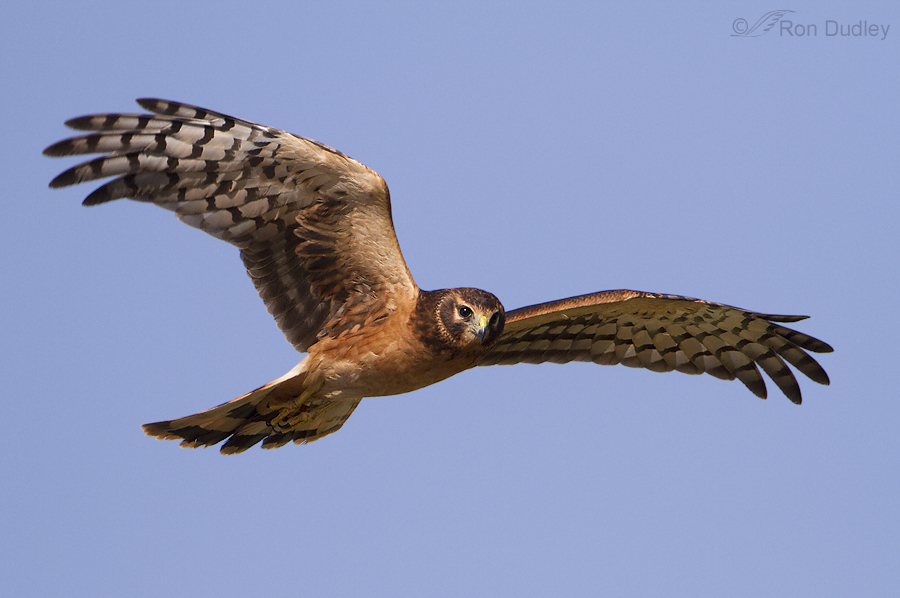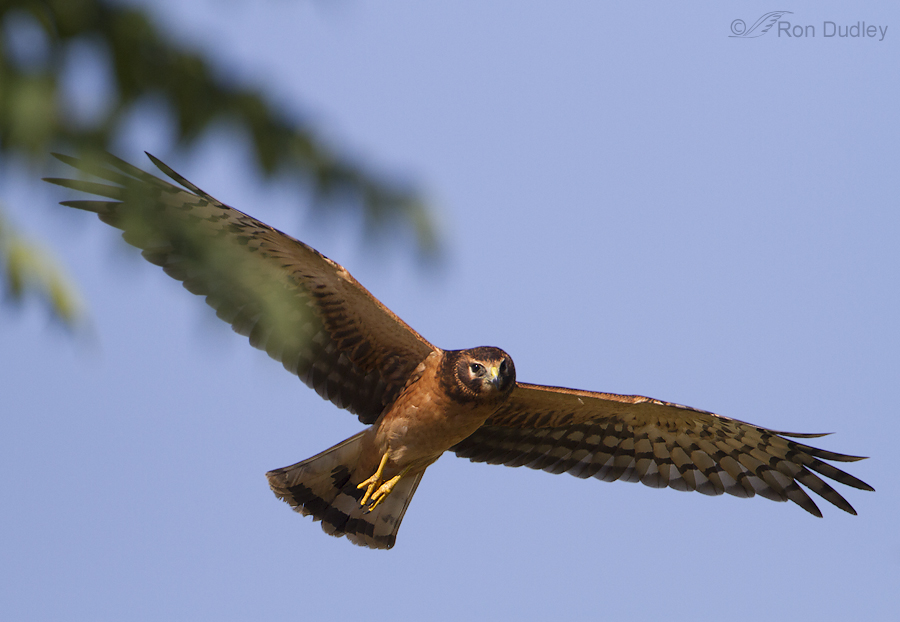Around here it can be relatively easy to get fairly close to the elusive Northern Harrier in the depths of winter. They seem to acclimate to all of the hunter traffic at the refuges and will often hunt very close to the dirt roads and are not spooked by traffic, so as long as I remain in my vehicle (usually) I can occasionally get some very nice close-up shots.
It’s another story altogether in the summer when these birds almost seem to have a built-in range-finder that tells them to veer off just before they get close enough to me for a quality photo. And in my experience they seem to instinctively fly between me and the sun whenever I get almost within range so that the light angle is poor anyway. Very frustrating!
1/2500, f/6.3, ISO 500, 500 f/4, 1.4 tc, natural light, not baited, set up or called in
I often shoot at Farmington Bay WMA where there’s a relatively large hill with trees near the top on one side. Harriers like to hunt the side of that hill. So on this mid-August morning (yes, summer!) I maneuvered my pickup to a position where the trees (and part of the hill) would be between me and any approaching harrier until the very last moment.
This female didn’t even know I was there until just before this shot was taken. In fact, several frames earlier there were branches from the tree in front of the birds right wing. She was quite surprised and immediately after this shot was taken she veered off sharply to my right.
At the last moment I’ve decided to include that shot to show you what I mean. This hawk had just noticed me.
Sometimes bird photographers have to be a little crafty to get the shot.
Ron




Sometimes, help doesn’t come from sources that one would expect. Thanks to this timely post, I finally have been able to identify a raptor I shot some frames of while out a few days ago. In my (until now) futile attempt to identify it, I had checked bird books, Fish and Game website, online posts, organizations (Cornell Orno, etc.) and nothing matched up with my shots. Then I found your post and there it was.
Because you like to relate circumstances and behavior I’ll include a recap. If my post is too long, I apologize.
My problem was this: I was walking in a narrow valley in a riparian zone with tall birch and cottonwoods on the fringe of conifer forest. There is some open grass in the small valley bottom. I noticed a raptor flying horizontally fairly low. So far, it could fit a harrier. Several problems. My angle and frequently obstructed view kept me from seeing the diagnostic white rump. Plus, every harrier I’ve seen displayed the flap/glide flight pattern with extended wings and flared tips. This bird was flying faster with more rapid beats, as well as the sharply angled wings and pointed tips of a falcon. It seemed smaller than a red tailed hawk and from my point of view seemed light colored. My first impression was a prairie falcon since they are in the area. Low flight can suggest a harrier, but without seeing a white rump, the light coloration and the wing shape, a falcon seemed more likely.
Or not.
Then this bird decided to confound my identification by changing flight behavior. It next caught a thermal and circled upward rather high with a more buteo-like flight pattern. Not what to expect from a falcon. With my view frequently obstructed by trees, I was only able to grab a few rapid fire shots (without proper settings since I’d been shooting a stationary songbird in bright sunlight moments before) at 500mm. Terrible indistinct photography resulted in the rush, but I wanted something for identification purposes.
After doing what I could to enhance and sharpen (alas, a disability makes hand-holding a long lens at 80 degrees – or whatever it was – and getting a clear long range shot of a circling bird tenuous, VR or not), the color and detail I could make out just didn’t fit anything I checked or my experience. It wasn’t until I saw your photos that the pieces fell into place. Tail shape and banding, body color and shape, wing pattern and coloration, dark “collar”, etc. My experience with harriers had never included overhead soaring flight so I had never seen the color/patterns in person and references didn’t match what was in the photos I checked. While my bird is evidently an adult female and yours is a juvenile, the patterns finally matched. The somewhat owlish face finally made sense.
So thank you not only for the great photography, but helping this person with a vexing raptor identification problem.
Incidentally, I got another lesson in software differences. Though I always start off with Nikon’s ViewNX2 software to see results, these shots were well beyond its capability to coax detail at that range. I turned first to Lightroom and was able to make progress. Some areas were still indistinct, especially the wings close to the body. This turned out to be important. I finally turned to DXO Optics Pro. Though the resulting rendition isn’t quite as “crisp” as with Lightroom, DXO allowed me to see more color detail, including better tail and wing markings. This definitely helped in identification by the time I saw your photos. I’ve been trying to decide whether to keep both software programs. Recent experience, including this, argues for it. Both have their advantages and I have found each produces better results in certain situations.
Evan, I’m glad this post helped you to ID your bird.
In my experience it’s not particularly unusual for a harrier to soar relatively high. Adult males seem to do it less but that may be because they’re smaller than the female.
I think I like the shot with the branches better. It tells the story of how it first spied you and adds an element of intrigue. Some wildlife painters intentionally paint grasses or branches in front of their subject to get the same effect.
As to Harriers coming out of the sun it reminds me of being attacked by a Prairie Falcon in WY. I repeated dove at me and every time coming straight out from the sun so I couldn’t see it in an otherwise clear sky. I’m guessing most raptors have this strategy figured out when conditions allow. Either that or they just want to challenge our photographic skills :).
Cheers,
Verm
Love the colors– it’s very warm-looking. That shot with the tree branches– her expression reminds me of my 4th grade teacher catching us doing something we shouldn’t have….and of course, thank you as always for the running commentary
Very nice shot Ron. Thanks for the info on keeping the engine going. You are absolutely right they spook when turning it off!
Clever. For which I thank you since we benefit as you did. A gorgeous bird.
Hi Ron,
You are indeed crafty. A GREAT image of a beautiful bird – up close and personal. Judging by the relatively unstreaked underparts and darker eyes, it appears to be an immature bird…? Thanks!
Thank you, Dick. Yes, I’d say this is a juvenile female since it doesn’t appear to have the pale greenish-yellow eyes of a juvie male. But I’ve been fooled before…
Great pictures!
Thanks, Sam.
Just wonderful Ron!
I appreciate your comment, Charlotte.
The effort you put into out-witting the Harrier was well worth it. The first photo is just gorgeous!
Sometimes things work out with this species, Susan. Usually they don’t, so you have to innovate a little.
Very nice.
My difficulty is with Red Tailed Hawks.
They seem to spook if my car even slows down…
Bruce, Strangely enough, I’ve found that many birds (raptors or not) fly off when I turn off my engine. The sudden change in sound spooks them. So I often leave the engine running for a couple of shots when I first approach a bird, just to make sure I get SOMETHING…